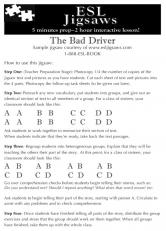ESL Jigsaws
5 Minutes Prep - 2 Hour Interactive Lesson!
What is a Jigsaw?
The jigsaw method could be described as "info gap squared." As the father of jigsaws, Professor Elliot Aronson says, it promotes positive interdependence and provides a simple method to ensure individual accountability. The jigsaw is a task-based approach that creates a genuine communication situation. Learn more about the rationale behind using jigsaws with your class.
Watch this video to get a 3 minute explanation of the method:
Watch this 9 minute video to learn how to use the jigsaw most successfully and how to make your own jigsaws:
In the jigsaw form of instruction, material is divided, usually into four parts, and distributed to small groups to learn.
When these homogeneous expert groups have mastered their material, students regroup into heterogeneous groups to present material and complete a task.
Peer teaching and group problem solving are used to complete the jigsaw task.
You may wish to start by pre-teaching the vocabulary in the jigsaw.

Initially, your classroom would look like this:
A A B B C C D D
A A B B C C D D
Once students have mastered their material, your classroom would look like this:
A B A B A B A B
C D C D C D C D
Check out one of the videos above for ideas on what to do if you don't have multiples of four in your class.
Alternatively, jigsaws can be divided into five parts or three. Get creative!
If you would like to know more about the rationale for using jigsaws in your classroom, click here.
For more information on the jigsaw teaching method, from the official site for the jigsaw classroom, please click here.
Or watch a video here about this cooperative learning strategy featuring the pioneer of the jigsaw method, Elliot Aronson.


